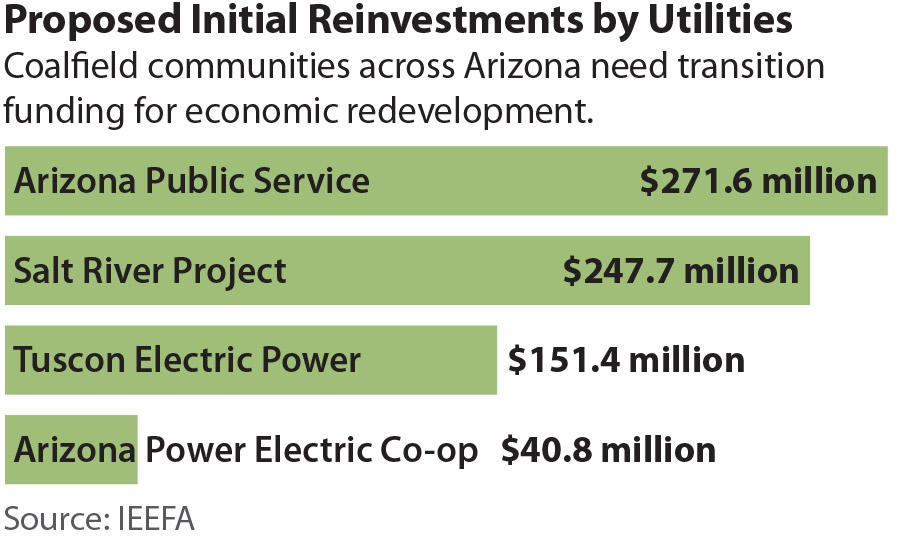IEEFA U.S: An ‘elegant, simple, and fair’ coalfield reinvestment formula for greater Arizona

March 24, 2020 (IEEFA U.S.) — Arizona utility company reinvestments of $726 million in coalfield community modernization would serve the economic interests of Arizonans across the board, concludes a research brief published today by the Institute for Energy Economics and Financial Analysis (IEEFA).
The brief, A Coalfield Reinvestment Formula for the Grand Canyon State, describes an approach by which utility companies can reinvest initially—voluntarily or otherwise—in several communities that offer reinvestment opportunities now.
Under the formula:
- Arizona Public Service (APS) would reinvest $271.6 million locally for the generation capacity it has owned over the years, including the Navajo Generating Station, Cholla Power Plant and the Four Corners Power Plant.
- Salt River Project (SRP) would reinvest $247.7 million locally for its ownership interests in the Navajo Generating Station, Coronado Generating Station, Springerville Generating Station and the Four Corners Power Plant.
- Tucson Electric Power would reinvest $151.4 million locally for its ownership stakes at Springerville Generating Station, San Juan Generating Station, Navajo Generating Station, and the Four Corners Power Plant.
- Arizona Electric Power Co-Op would reinvest $40.8 million locally for its ownership of the Apache Generating Station.
The calculations follow a formula suggested during the TEP rate case hearing in January by Jonathan Nez, president of Navajo Nation. Hopi leaders have also endorsed the Navajo proposal. Much of Arizona’s reliance on coal-fired power has been supported by the Navajo and Hopi communities that are now being abandoned by the utility companies.
The formula assigns $100,000 in initial reinvestment outlays for every megawatt of coal-fired power generation owned over the years by the four utility companies across the energy economy of greater Arizona, which includes northwestern New Mexico, one of the cornerstones of the electrification of urban, suburban and parts of rural Arizona.
“The Navajo formula is elegant, simple, and fair,” said Karl Cates, an IEEFA policy analyst and lead author of the brief. “Its broader application would replace lost tax revenues and jobs while driving power sector modernization around existing power-transmission infrastructure. It would tap into skilled work forces that have operated coal mines and coal-fired plants since the 1970s, and drive serious reinvestment in important non-energy infrastructure, healthcare, and education.”
The brief builds on an IEEFA report published in February (The Case (and the Mechanisms) for Utility-Company Reinvestment in Arizona’s Coalfield Communities ) examining three mechanisms by which initial reinvestment could be directed: by the Arizona Corporation Commission, by the SRP board, or by legislative action.
“Coalfield economies across greater Arizona are ripe for reinvestment,” the new brief notes. “They include, most immediately, the communities around the former Navajo Generating Station and Kayenta Mine, both of which closed a few months ago. They also include the communities surrounding the Four Corners Power Plant and the San Juan Generating Station in northwest New Mexico, aging coal-fired plants that are scheduled for shutdown. Other communities are at risk including those near coal-fired plants, such as Coronado Generating Station, Cholla Power Plant, Springerville Generating Station and Apache Generating Station.”
The brief also points out that the coalfield communities in question are part of a larger national patchwork facing a post-coal world that favors other forms of power generation.
“Nothing about what is happening to the coalfield communities of greater Arizona is occurring in isolation. The American coal industry is collapsing across the board as momentum gathers around market forces that favor other forms of power generation.”
It notes as well that major coalfield reinvestment initiatives have taken root elsewhere in the U.S., notably in Colorado and Washington, as well as in Germany.
“Arizona utility companies can follow—or can be made to follow—these examples in a way that ensures reinvestment on a similar, responsible scale across the state’s coalfield communities, all of which are open for reinvestment now and for the foreseeable future,” it concludes.
Full report: A Coalfield Reinvestment Formula for the Grand Canyon State
Author Contact: Karl Cates, ([email protected]), tel: (917) 439-8225
Media Contact: Vivienne Heston, ([email protected]), tel: (914) 439-8921
About IEEFA
The Institute for Energy Economics and Financial Analysis (IEEFA) conducts global research and analyses on financial and economic issues related to energy and the environment. The Institute’s mission is to accelerate the transition to a diverse, sustainable and profitable energy economy.












